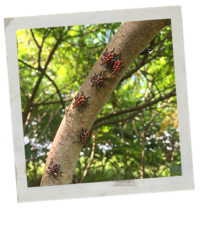
Other names: Spotted lanternfly, Lycorma delicatula
Plants susceptible: Over 100 species but especially tree of heaven, grapes, fruit trees, black walnuts, hops, roses, red maple, and river birch.
Where did it come from?
It was first introduced on imported stone from south eastern Asia and was found in Pennsylvania in 2014. It is currently found in Northeast and Southeast Indiana and is spreading rapidly. If you see it, report it.
Why is it invasive?
Spotted lanternfly feeds on sap from stem or leaves on plants, weakening the plant overall. This damage can kill small plants and is particularly devastating to vineyards and fruit orchards. The honeydew they produce covers the ground and attracts ants, wasps, and grows mold.
How do you prevent its spread?
Report it if you see it! If you travel through affected states, check your luggage, vehicle, and anything you purchase there. If you order anything from affected areas, make sure to inspect it when you receive it.
Resources:
https://www.in.gov/dnr/entomology/pests-of-concern/spotted-lanternfly/
Seen it? Report it! Through the app, online, by email, or by phone (1-866-663-9684).
Image credit: Pennsylvania State Extension